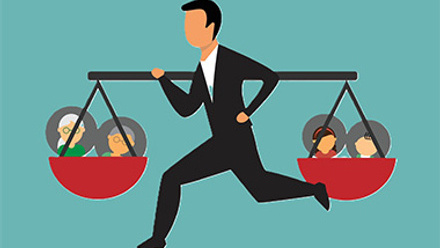3 ways to help Gen Z employees avoid burnout – Aviva report
With more than seven in 10 employees (74%) viewing work as a way of earning enough money to do the things they want in life and almost two in three (61%) saying their focus is on earning as much as they can rather than doing a job they love, burnout may sneak up on employees’ mental health.
And although stress is a defining characteristic of burnout, it’s more than that.
Burnout comes from chronic workplace stress that isn’t managed. While stress may be experienced as anxiety and feeling a sense of urgency, burnout may further present itself as feeling helpless, hopeless or apathetic.
Some 40% of employees, at the UK’s largest companies, feel that they can never switch off from work, with half (49%) of full-time employees feeling this way. And this may be impacting Gen Z as they navigate their working lives while balancing modern challenges.
Mental health risk
For Gen Z, those born between 1997 and 2012, who may be in the early stages of their career, burnout may pose a particular risk to their mental health. Nearly half (48%) of 18 to 25-year-olds are either ‘very’ or ‘fairly’ concerned about job burnout, according to the Mastering the Age of Ambiguity report.
And the consequences of burnout, for both employees and their employers, is not only harmful to personal wellbeing, but also to businesses. This may be through increased absenteeism, with employees taking time off to cope with stress and exhaustion. But it may also mean lower productivity as employees lose motivation and choose to either leave their jobs or ‘quietly quit’ – remaining at work but doing only what their job role specifies and no more.
For Gen Z, looking to their employer could be the first step to preventing, reducing, or healing burnout. And while experience of each Gen Z employee is individual, there are ways to support them with practical and tailored guidance.
Here are three cost effective ways that businesses can help their Gen Z employees avoid or handle burnout.
1. Carry out a workplace mental health audit
The first step of healing and improving health, be that business or person, is recognising the extent of a problem. In this case, it’s not only recognising the causes of burnout, but also giving employees the chance to be honest about workplace experiences.
Creating anonymous surveys, especially ones relevant to Gen Z’s working lives, may be a powerful way to understand the scope of burnout. Including questions that reflect the causes of burnout could include whether employees feel:
- unreasonable demands are placed upon them
- they have unclear job or role expectations
- they expect too much of themselves
- inadequate or incompetent
- unsupported or unappreciated
- unable to switch off
- they work long hours without breaks
Having a balance between open and closed questions in the survey could help business leaders target areas for improvement while giving younger employees the chance to voice any concerns. Encouraging employees to have regular and open conversations can also help create a sense of belonging, trust and build a strong social purpose.
2. Review HR policies
Burnout can be sneaky, hiding in the grey areas of unclear workplace policies, which may inflame anxieties. Finding policies that are confusing or difficult to understand, especially around flexible working situation, home working or break times, may be the first step to promoting clear communication about reasonable expectations.
Developing HR policies to manage workloads and give employees enough time to recuperate after a busy, stressful day at work could help employees rebalance their energy and focus. Ensuring line managers are supported and have awareness of these policies and can signpost their colleagues to the relevant area will help bring consistency and a more positive attitude and relationship between colleagues and the wider business.
3. Become a wellbeing champion
Creating a business culture that emphasises and encourages wellbeing in the workplace may help prevent or tame the flames of burnout. This could take shape in many ways, depending on what works best for your business, and may include:
- making work-life balance a priority by encouraging employees to take regular breaks, giving time back if they’ve worked overtime or had a significant workload for some time, and encouraging social opportunities or workout programmes.
- modelling appropriate behaviours from the top – when line managers are explicit in maintaining a good work-life balance for themselves by taking holiday and flexibly managing their time, they are signalling through their actions what the norm for that particular workplace is.
- a resource hub that pulls together and organises information based on career progression or stage. This means those in the early stages of their career, Gen Z, have specific support they can access when needed.
- signposting apps that focus on improving mental health, such as mindfulness and meditation, or mental health champions on social media.
- an online support forum that allows employees to discuss their challenges, find support through resources and connect with colleagues who may share their experiences. Part of dealing with burnout, or any mental health challenge, is recognising you’re not alone.
To learn more, download our Employer’s Guide to Burnout.
For more about supporting employee wellbeing, visit Aviva Business Perspectives.
Supplied by REBA Associate Member, Aviva
Our purpose is to be with you today, for a better tomorrow.








